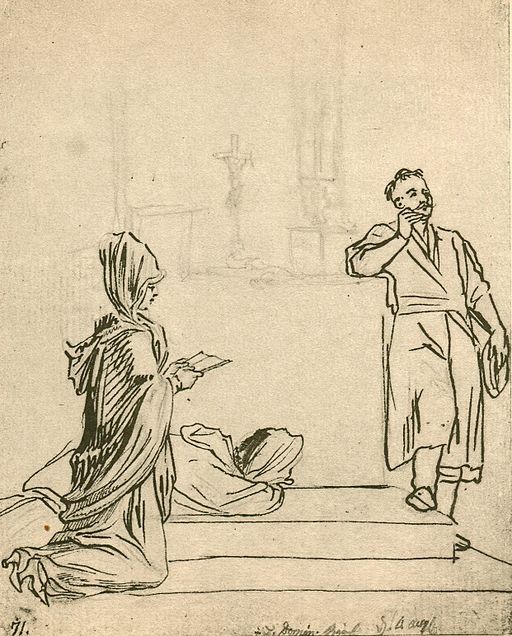
by Daniel Chodowiecki (Wikimedia Commons)
This series by Dan Burke originally ran at SpiritualDirection.com. It is reposted her (slightly edited) by persmission.
In this third post we will explore the dangers of reducing God to a cosmic force along with ways we can better gain a healthy perspective on prayer and enhance rather than diminish our progress in prayer (you can read the first post here and the second post here).
Depersonalization
The final and most dangerous aspect of modern popular teaching on prayer is depersonalization. The danger here lies in an essential denial of two central doctrines of Christianity: first, the Incarnation (Christ really did come in the flesh) and second, the distinction between Creator and creature (I am not God and He is not me).
The historical reality of the Incarnation of Christ leads us to the critical understanding that God is person and we can commune with Him as such. This is similar to saying, “My wife is a person, and I am a person, and therefore we can commune most fully as persons.” Now, if I were to treat my wife not as a person but as an ethereal cosmic being, communication would break down in short order.
We can envision two contrasting scenarios that illustrate this point.
1. In the non-person prayer orientation, the husband claims to love his wife and yet stares past her in a self-entranced muttering while she stands ignored. It doesn’t matter that he intends or wants to love her, or is open to loving her; his approach is self-centered rather than other-centered.
2. In a person-oriented understanding of prayer, the adoring husband kneels before his spouse and recites poetry rooted in an exalted language of love and adoration. As he offers his love, all his attention is focused on her. She receives his love, as it is clearly for her alone. This is true intimacy, even if only the beginning of a more complete intimacy of the marital embrace.
God is not a distant idea or cosmic force to be communed with in some dazed stupor or blank mind created by the misuse of a mantra-centered method. These distant, ephemeral, and spiritual sounding descriptions of God and their related ideas are acid to the soul. They radically misrepresent who God is, how He has chosen to reveal himself to us, and what it means to be in a personal relationship with Him.
If God is in any way depersonalized, then his Incarnational essence and personhood can easily be morphed into some kind of cosmic force to be harnessed or absorbed into. Even worse, this can and does lead unsuspecting Catholics into the pseudo-faith of pantheism: “He is everything, and thus I am He.” In the end, the gurus of this false gospel seek to lead the naive practitioner to the center of their being where they then discover who they really are. The great triumph of this false prayer is the “realization” that we are God, because there is no substantive distinction between us (they call this “non-dual thinking”). Clearly, this idolatry will in no way lead us to heaven and is most definitely leading many down the broad path to spiritual destruction.
How can I protect myself?
The key to avoiding these errors is to be aware of them, but not to focus on them. Instead, we need to immerse ourselves in the truth. How? Begin with spiritual reading and meditation on the Catechism, and the Compendium of the Catechism, on the topic of prayer. These treatments are far from dry and, word for word, are the most valuable teachings on the topic in all of the Church aside from the words of Christ Himself. Second, we should immerse ourselves in the writings of the doctors of the Church, particularly those who have come to bear significant influence on how the Church understands what it means to commune with God (like Saints Teresa of Avila, John of the Cross, and Thérèse of Lisieux). Modern writers like Fr. Thomas Dubay and Fr. Jacques Philippe provide fantastic resources on prayer that are faithful to this profound and rich Catholic tradition.
Beyond these helpful resources, there are a handful of publishers of materials on prayer and the spiritual life that can be trusted without reservation. Three of these are Emmaus Road Publishing, Ignatius Press, and Scepter Publishing. Emmaus Road publishes my book, Navigating the Interior Life, in which I provide a time-tested and practical road map to understanding spiritual direction and what it means to enter into a progressively deeper relationship with our Lord. They also publish Ralph Martin’s marvelous work on this topic entitled, Fulfillment of All Desire. For more recommended reading on prayer and the spiritual life, check out EWTN’s Religious Catalogue.
Finally, we should close with a profound example of an authentic relationship with God – a look into a heart that truly understands what it means to commune with the Blessed Trinity. In Blessed Elizabeth of the Trinity’s prayer, we find a living and beautiful dismantling of all of the errors we have discussed in this series of posts.
“O my God, Trinity whom I adore, let me entirely forget myself that I may abide in you, still and peaceful as if my soul were already in eternity; let nothing disturb my peace nor separate me from you, O my unchanging God, but that each moment may take me further into the depths of your mystery! Pacify my soul! Make it your heaven, your beloved home and place of your repose; let me never leave you there alone, but may I be ever attentive, ever alert in my faith, ever adoring and all given up to your creative action.
O my beloved Christ, crucified for love, would that I might be for you a spouse of your heart! I would anoint you with glory, I would love you – even unto death! Yet I sense my frailty and ask you to adorn me with yourself; identify my soul with all the movements of your soul, submerge me, overwhelm me, substitute yourself in me that my life may become but a reflection of your life. Come into me as Adorer, Redeemer and Savior.
O Eternal Word, Word of my God, would that I might spend my life listening to you, would that I might be fully receptive to learn all from you; in all darkness, all loneliness, all weakness, may I ever keep my eyes fixed on you and abide under your great light; O my Beloved Star, fascinate me so that I may never be able to leave your radiance.
O Consuming Fire, Spirit of Love, descend into my soul and make all in me as an incarnation of the Word, that I may be to him a super-added humanity wherein he renews his mystery; and you O Father, bestow yourself and bend down to your little creature, seeing in her only your beloved Son in whom you are well pleased.
O my `Three,’ my All, my Beatitude, infinite Solitude, Immensity in whom I lose myself, I give myself to you as a prey to be consumed; enclose yourself in me that I may be absorbed in you so as to contemplate in your light the abyss of your [greatness]!” (http://www.elisabeth-dijon.org/v_en/prayer.html)
Dan Burke is the Managing Editor of the National Catholic Register, President of the Avila Institute, the administrator of SpiritualDirection.com, and the author of several books on mystical theology.

